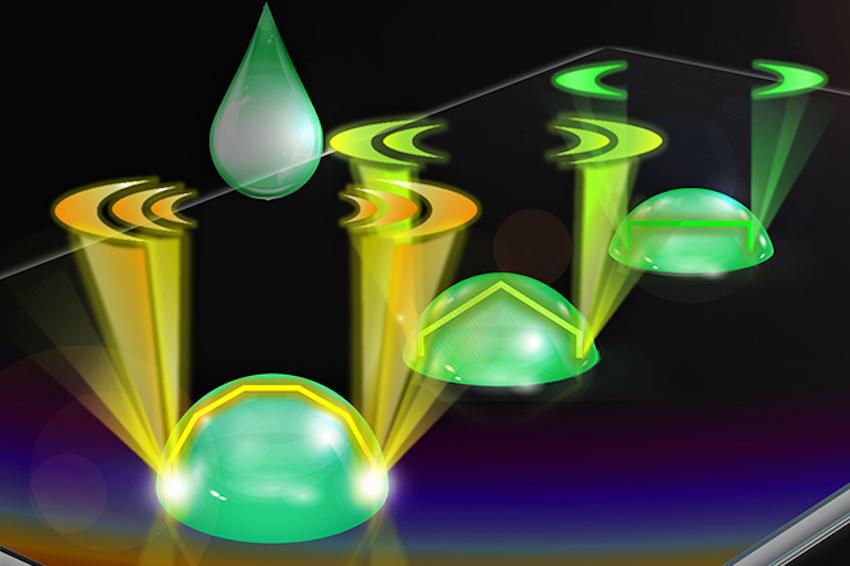Lasing mechanism in water droplets
03.02.2021 - Detailed view on the mechanism of droplet lasers when interacting with a droplet–solid interface.
Tiny molecular forces at the surface of water droplets can play a big role in laser output emissions. As the most fundamental matrix of life, water drives numerous essential biological activities, through interactions with biomolecules and organisms. Studying the mechanical effects of water-involved interactions contributes to the understanding of biochemical processes. According to Yu-Cheng Chen, professor of electronic engineering at Nanyang Technological University (NTU), “As water interacts with a surface, the hydrophobicity at the bio-interface mainly determines the mechanical equilibrium of the water. Molecular hydrophobicity at the interface can serve as the basis for monitoring subtle biomolecular interactions and dynamics.”
Water droplets have been used to form biological microlasers that exploit water's intrinsic ability to confine light with minimal scattering. Droplet lasers benefit from laser oscillation in a microcavity, so any subtle changes induced by the gain medium or cavity can be amplified, leading to dramatic changes of laser emission characteristics. While droplet lasers have become cutting-edge platforms in biochemical/physical studies and biomedical applications, the optical interaction between droplet resonators and an interface has remained unknown. Chen's NTU team recently discovered that when a water droplet interacts with a surface to form a contact angle, the interfacial molecular forces determine the geometry of a droplet resonator. Dramatic mechanical changes at the interface play a significant role in the optical oscillation of droplet resonators.
Chen's group discovered an oscillation mechanism of droplet resonators, in which the laser resonates along the droplet-air interface in the vertical plane. Chen notes that this vertically oriented rainbow-like or arc-like lasing mode reflects back and forth between the two ends of the droplet interface, forming a unique and extremely strong laser emission. Chen's team noticed that, unlike the commonly seen whispering-gallery mode (WGM), this newly discovered lasing mechanism is much more sensitive to interfacial molecular forces. According to Chen, “The lasing emissions of this arc-like mode increase dramatically with the increment of interfacial hydrophobicity, as well as droplet contact angle.”
Seeking to explain this modulating phenomenon, Chen's team also found that the quality-factor of new lasing modes increased significantly with an increasing droplet contact angle. And the number of oscillation paths of lasing modes in droplets increased dramatically. “Together, these two factors determine the enhancement of lasing emissions with the strength of interfacial molecular forces,” says Chen. Based on their discovery, Chen's team explored the possibility of employing droplet lasers to record mechanical changes at biointerfaces. As anticipated, they found that a tiny change of interfacial biomolecular forces, induced by a very low concentration of biomolecules, such as peptides or proteins, can be recorded by the lasing emissions of droplet lasers.
According to Chen, “This work demonstrates an important modulating mechanism in droplet resonators and shows the potential for exploiting optical resonators to amplify the changes of intermolecular forces.” Lasing mechanism insights open new prospects for using microlasers to study biomechanical interactions and interface physics. As droplet lasers may provide a new platform for studying the intermolecular physical interactions at the interface, they could be particularly useful for examining hydrophobic interactions, which play a vital role in numerous physical dynamics and biological systems. (Source: SPIE)






